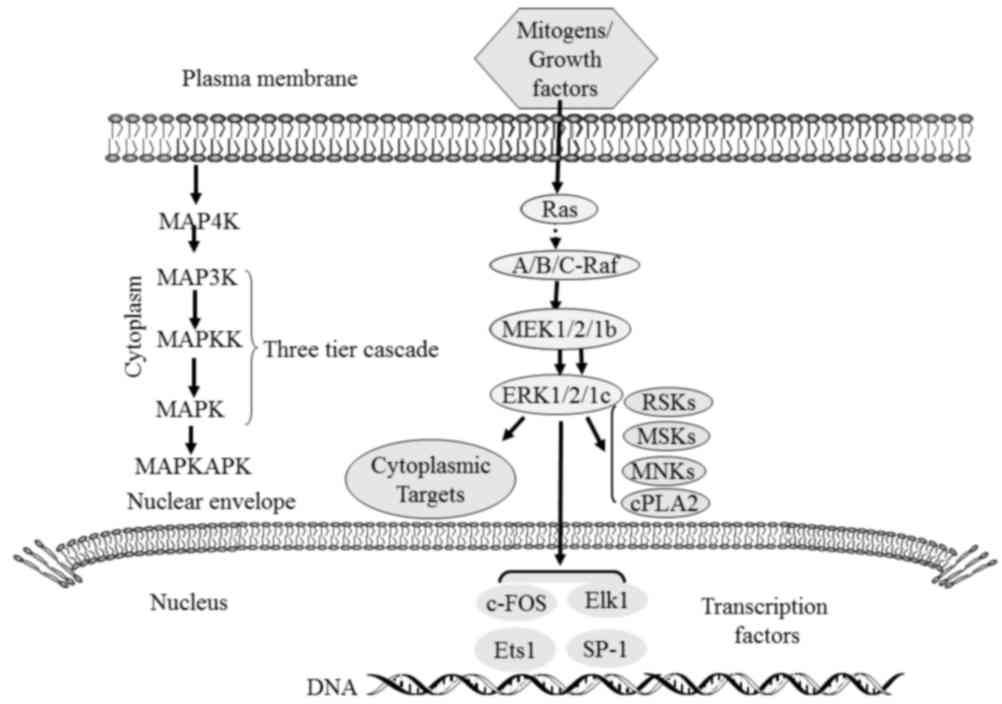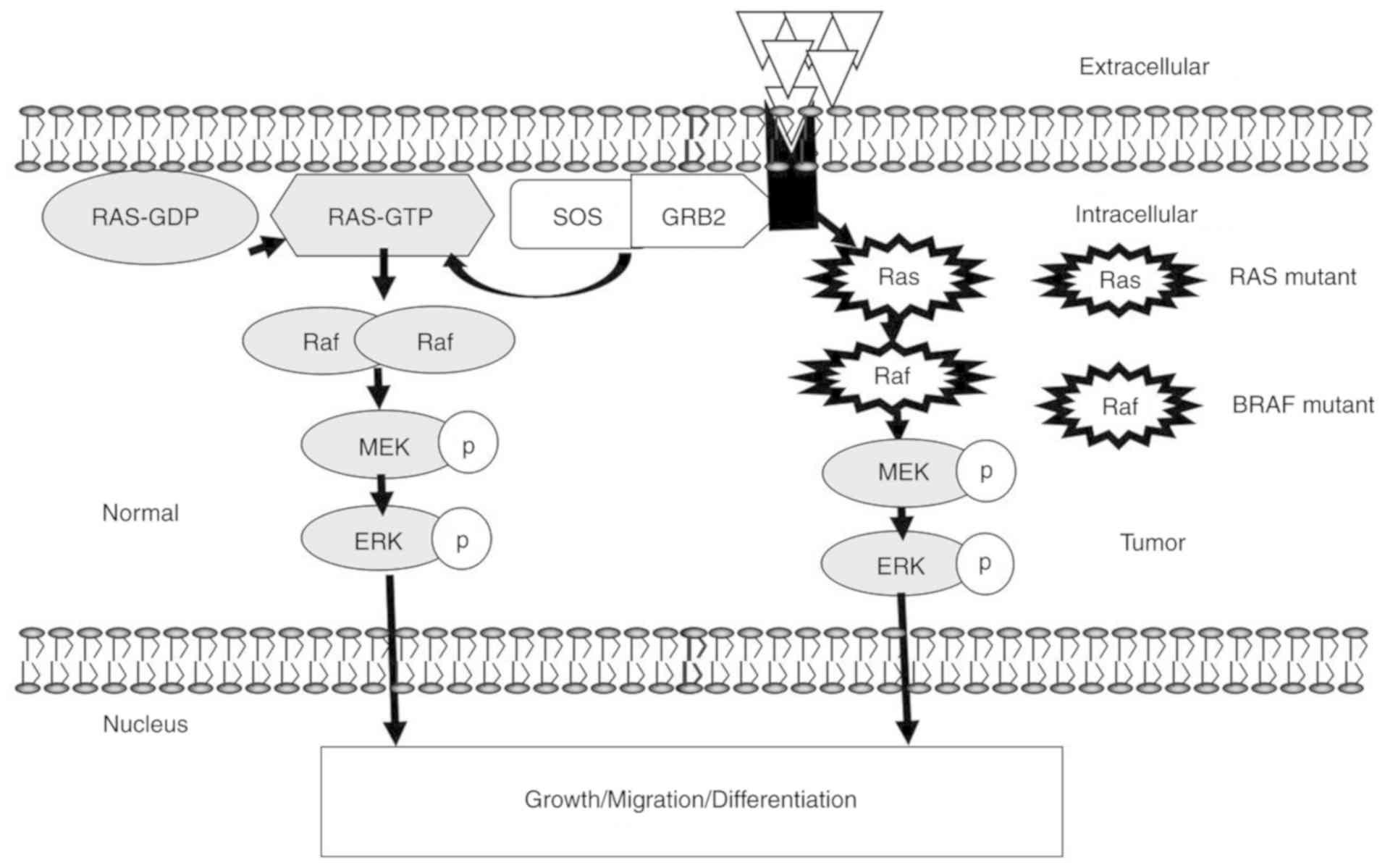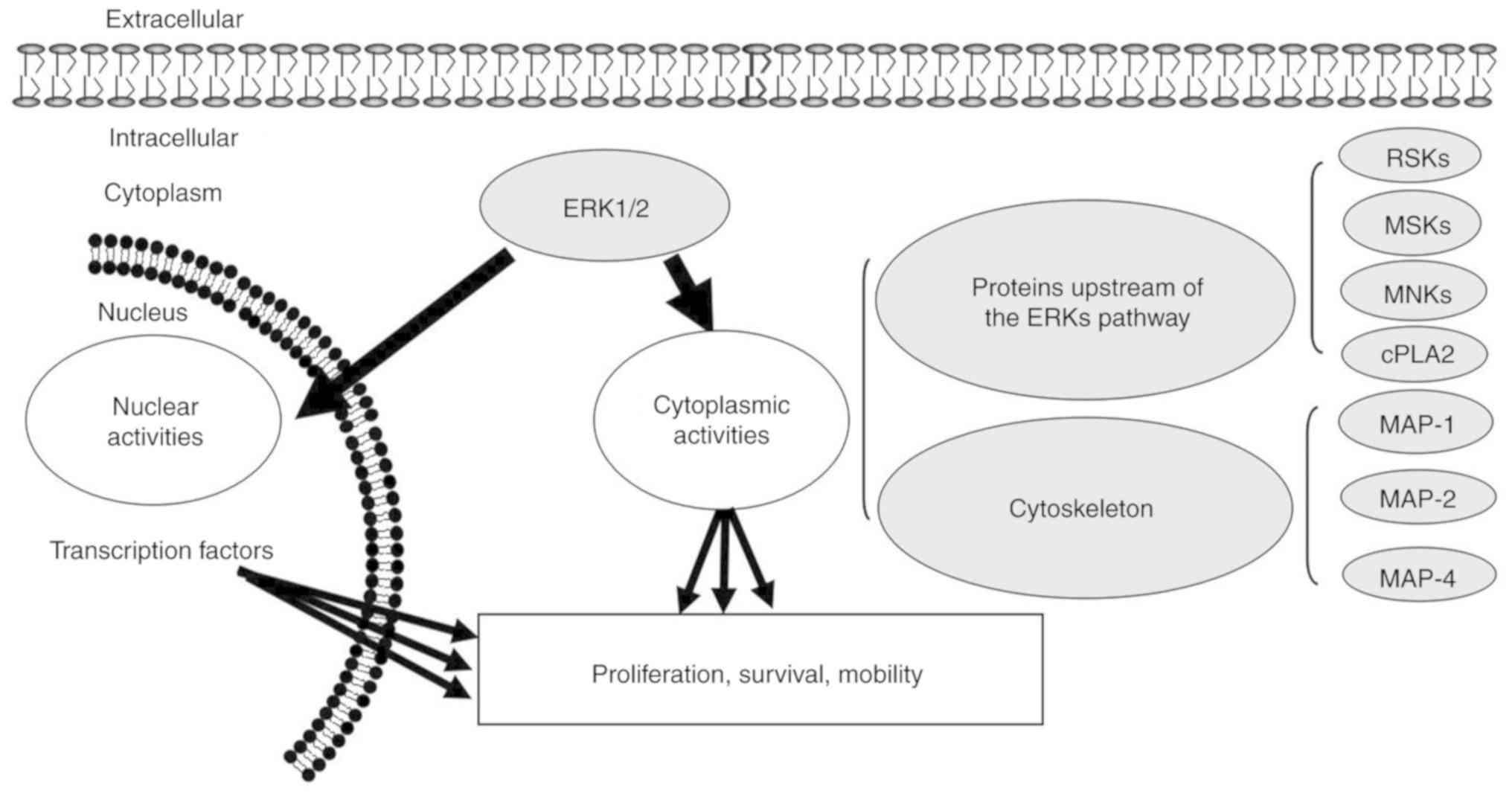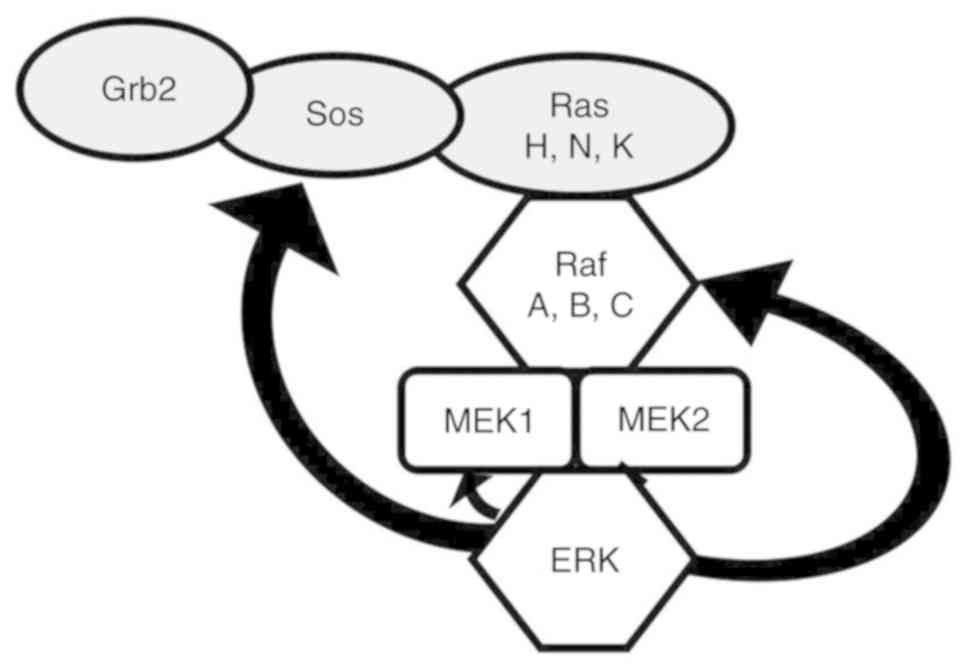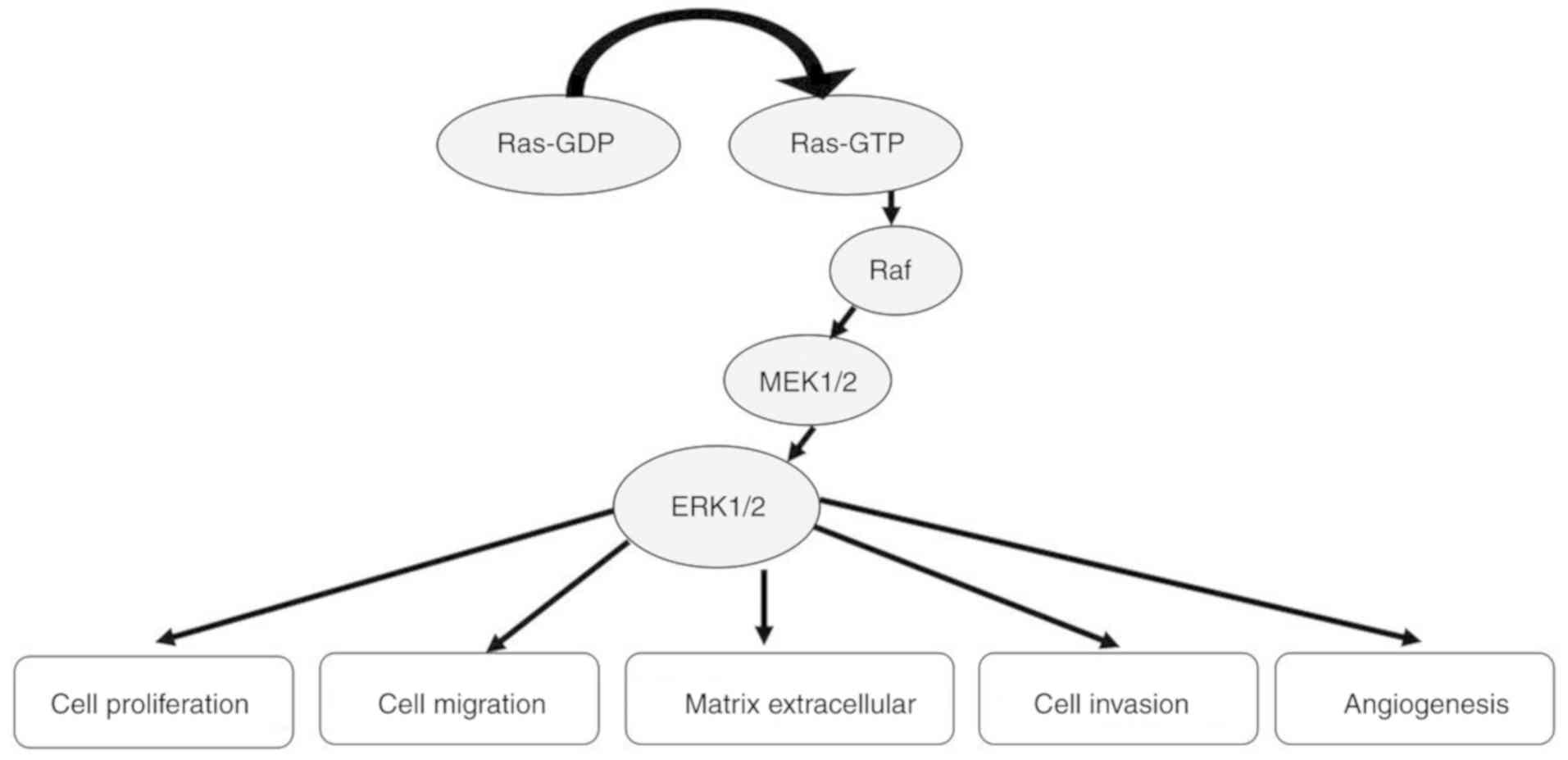|
1
|
Keshet Y and Seger R: The MAP kinase
signaling cascades: A system of hundreds of components regulates a
diverse array of physiological functions. Methods Mol Biol.
661:3–38. 2010. View Article : Google Scholar : PubMed/NCBI
|
|
2
|
Sabio G and Davis RJ: TNF and MAP kinase
signalling pathways. Semin Immunol. 26:237–245. 2014. View Article : Google Scholar : PubMed/NCBI
|
|
3
|
Plotnikov A, Zehorai E, Procaccia S and
Seger R: The MAPK cascades: Signaling components, nuclear roles and
mechanisms of nuclear translocation. Biochim Biophys Acta.
1813:1619–1633. 2011. View Article : Google Scholar : PubMed/NCBI
|
|
4
|
Eblen ST: Extracellular-regulated kinases:
Signaling from ras to ERK substrates to control biological
outcomes. Adv Cancer Res. 138:99–142. 2018. View Article : Google Scholar : PubMed/NCBI
|
|
5
|
Roskoski R Jr: ERK1/2 MAP kinases:
Structure, function, and regulation. Pharmacol Res. 66:105–143.
2012. View Article : Google Scholar : PubMed/NCBI
|
|
6
|
Wortzel I and Seger R: The ERK cascade:
Distinct functions within various subcellular organelles. Genes
Cancer. 2:195–209. 2011. View Article : Google Scholar : PubMed/NCBI
|
|
7
|
Seternes OM, Kidger AM and Keyse SM:
Dual-specificity MAP kinase phosphatases in health and disease.
Biochim Biophys Acta Mol Cell Res. 1866:124–143. 2019. View Article : Google Scholar : PubMed/NCBI
|
|
8
|
Patterson KI, Brummer T, O'Brien PM and
Daly RJ: Dual-specificity phosphatases: Critical regulators with
diverse cellular targets. Biochem J. 418:475–489. 2009. View Article : Google Scholar : PubMed/NCBI
|
|
9
|
Zhou B, Wang ZX, Zhao Y, Brautigan DL and
Zhang ZY: The specificity of extracellular signal-regulated kinase
2 dephosphorylation by protein phosphatases. J Biol Chem.
277:31818–31825. 2002. View Article : Google Scholar : PubMed/NCBI
|
|
10
|
Yao Z and Seger R: The molecular mechanism
of MAPK/ERK inactivation. Curr Genomics. 5:385–393. 2004.
View Article : Google Scholar
|
|
11
|
Kolch W: Coordinating ERK/MAPK signalling
through scaffolds and inhibitors. Nat Rev Mol Cell Biol. 6:827–837.
2005. View
Article : Google Scholar : PubMed/NCBI
|
|
12
|
Morrison DK and Davis RJ: Regulation of
MAP kinase signaling modules by scaffold proteins in mammals. Annu
Rev Cell Dev Biol. 19:91–118. 2003. View Article : Google Scholar : PubMed/NCBI
|
|
13
|
Chuderland D and Seger R: Protein-protein
interactions in the regulation of the extracellular
signal-regulated kinase. Mol Biotechnol. 29:57–74. 2005. View Article : Google Scholar : PubMed/NCBI
|
|
14
|
Shaul YD and Seger R: The MEK/ERK cascade:
From signaling specificity to diverse functions. Biochim Biophys
Acta. 1773:1213–1226. 2007. View Article : Google Scholar : PubMed/NCBI
|
|
15
|
Marshall CJ: Specificity of receptor
tyrosine kinase signaling: Transient versus sustained extracellular
signal-regulated kinase activation. Cell. 80:179–185. 1995.
View Article : Google Scholar : PubMed/NCBI
|
|
16
|
Wainstein E and Seger R: The dynamic
subcellular localization of ERK: Mechanisms of translocation and
role in various organelles. Curr Opin Cell Biol. 39:15–20. 2016.
View Article : Google Scholar : PubMed/NCBI
|
|
17
|
Yao Z and Seger R: The ERK signaling
cascade-views from different subcellular compartments. Biofactors.
35:407–416. 2009. View
Article : Google Scholar : PubMed/NCBI
|
|
18
|
Kim JY, Lee SG, Chung JY, Kim YJ, Park JE,
Koh H, Han MS, Park YC, Yoo YH and Kim JM: Ellipticine induces
apoptosis in human endometrial cancer cells: The potential
involvement of reactive oxygen species and mitogen-activated
protein kinases. Toxicology. 289:91–102. 2011. View Article : Google Scholar : PubMed/NCBI
|
|
19
|
Yoshizumi M, Kyotani Y, Zhao J, Nagayama
K, Ito S, Tsuji Y and Ozawa K: Role of big mitogen-activated
protein kinase 1 (BMK1)/extracellular signal-regulated kinase 5
(ERK5) in the pathogenesis and progression of atherosclerosis. J
Pharmacol Sci. 120:259–263. 2012. View Article : Google Scholar : PubMed/NCBI
|
|
20
|
Bogoyevitch MA, Ngoei KR, Zhao TT, Yeap YY
and Ng DC: c-Jun N-terminal kinase (JNK) signaling: Recent advances
and challenges. Biochim Biophys Acta. 1804:463–475. 2010.
View Article : Google Scholar : PubMed/NCBI
|
|
21
|
Wagner EF and Nebreda AR: Signal
integration by JNK and p38 MAPK pathways in cancer development. Nat
Rev Cancer. 9:537–549. 2009. View Article : Google Scholar : PubMed/NCBI
|
|
22
|
Gupta J and Nebreda AR: Roles of p38α
mitogen-activated protein kinase in mouse models of inflammatory
diseases and cancer. FEBS J. 282:1841–1857. 2015. View Article : Google Scholar : PubMed/NCBI
|
|
23
|
García-Gómez R, Bustelo XR and Crespo P:
Protein-protein interactions: Emerging oncotargets in the RAS-ERK
pathway. Trends Cancer. 4:616–633. 2018. View Article : Google Scholar : PubMed/NCBI
|
|
24
|
Khotskaya YB, Holla VR, Farago AF, Mills
Shaw KR, Meric-Bernstam F and Hong DS: Targeting TRK family
proteins in cancer. Pharmacol Ther. 173:58–66. 2017. View Article : Google Scholar : PubMed/NCBI
|
|
25
|
Maik-Rachline G, Hacohen-Lev-Ran A and
Seger R: Nuclear ERK: Mechanism of translocation, substrates, and
role in cancer. Int J Mol Sci. 20(pii): E11942019. View Article : Google Scholar : PubMed/NCBI
|
|
26
|
Sanchez-Vega F, Mina M, Armenia J, Chatila
WK, Luna A, La KC, Dimitriadoy S, Liu DL, Kantheti HS, Saghafinia
S, et al: Oncogenic signaling pathways in the cancer genome atlas.
Cell. 173:321–337.e10. 2018. View Article : Google Scholar : PubMed/NCBI
|
|
27
|
Holderfield M, Deuker MM, McCormick F and
McMahon M: Targeting RAF kinases for cancer therapy: BRAF-mutated
melanoma and beyond. Nat Rev Cancer. 14:455–467. 2014. View Article : Google Scholar : PubMed/NCBI
|
|
28
|
Kyriakis JM and Avruch J: Mammalian
mitogen-activated protein kinase signal transduction pathways
activated by stress and inflammation. Physiol Rev. 81:807–869.
2001. View Article : Google Scholar : PubMed/NCBI
|
|
29
|
Khokhlatchev AV, Canagarajah B, Wilsbacher
J, Robinson M, Atkinson M, Goldsmith E and Cobb MH: Phosphorylation
of the MAP kinase ERK2 promotes its homodimerization and nuclear
translocation. Cell. 93:605–615. 1998. View Article : Google Scholar : PubMed/NCBI
|
|
30
|
Chang L and Karin M: Mammalian MAP kinase
signalling cascades. Nature. 410:37–40. 2001. View Article : Google Scholar : PubMed/NCBI
|
|
31
|
Yang S and Liu G: Targeting the
Ras/Raf/MEK/ERK pathway in hepatocellular carcinoma. Oncol Lett.
13:1041–1047. 2017. View Article : Google Scholar : PubMed/NCBI
|
|
32
|
Anjum R and Blenis J: The RSK family of
kinases: Emerging roles in cellular signalling. Nat Rev Mol Cell
Biol. 9:747–758. 2008. View Article : Google Scholar : PubMed/NCBI
|
|
33
|
Boulton TG, Nye SH, Robbins DJ, Ip NY,
Radziejewska E, Morgenbesser SD, DePinho RA, Panayotatos N, Cobb MH
and Yancopoulos GD: ERKs: A family of protein-serine/threonine
kinases that are activated and tyrosine phosphorylated in response
to insulin and NGF. Cell. 65:663–675. 1991. View Article : Google Scholar : PubMed/NCBI
|
|
34
|
Morimoto H, Kondoh K, Nishimoto S,
Terasawa K and Nishida E: Activation of a C-terminal
transcriptional activation domain of ERK5 by autophosphorylation. J
Biol Chem. 282:35449–35456. 2007. View Article : Google Scholar : PubMed/NCBI
|
|
35
|
Buschbeck M and Ullrich A: The unique
C-terminal tail of the mitogen-activated protein kinase ERK5
regulates its activation and nuclear shuttling. J Biol Chem.
280:2659–2667. 2005. View Article : Google Scholar : PubMed/NCBI
|
|
36
|
Nishimoto S and Nishida E: MAPK
signalling: ERK5 versus ERK1/2. EMBO Rep. 7:782–786. 2006.
View Article : Google Scholar : PubMed/NCBI
|
|
37
|
Kondoh K, Terasawa K, Morimoto H and
Nishida E: Regulation of nuclear translocation of extracellular
signal-regulated kinase 5 by active nuclear import and export
mechanisms. Mol Cell Biol. 26:1679–1690. 2006. View Article : Google Scholar : PubMed/NCBI
|
|
38
|
Yan C, Luo H, Lee JD, Abe J and Berk BC:
Molecular cloning of mouse ERK5/BMK1 splice variants and
characterization of ERK5 functional domains. J Biol Chem.
276:10870–10878. 2001. View Article : Google Scholar : PubMed/NCBI
|
|
39
|
Zhou B, Der CJ and Cox AD: The role of
wild type RAS isoforms in cancer. Semin Cell Dev Biol. 58:60–69.
2016. View Article : Google Scholar : PubMed/NCBI
|
|
40
|
Muñoz-Maldonado C, Zimmer Y and Medová M:
A comparative analysis of individual RAS mutations in cancer
biology. Front Oncol. 9:10882019. View Article : Google Scholar : PubMed/NCBI
|
|
41
|
Dohlman HG and Campbell SL: Regulation of
large and small G proteins by ubiquitination. J Biol Chem.
294:18613–18623. 2019. View Article : Google Scholar : PubMed/NCBI
|
|
42
|
Terrell EM and Morrison DK: Ras-mediated
activation of the raf family kinases. Cold Spring Harb Perspect
Med. 9(pii): a0337462019. View Article : Google Scholar : PubMed/NCBI
|
|
43
|
Bandaru P, Kondo Y and Kuriyan J: The
interdependent activation of son-of-sevenless and ras. Cold Spring
Harb Perspect Med. 9(pii): a0315342019. View Article : Google Scholar : PubMed/NCBI
|
|
44
|
Simanshu DK, Nissley DV and McCormick F:
RAS proteins and their regulators in human disease. Cell.
170:17–33. 2017. View Article : Google Scholar : PubMed/NCBI
|
|
45
|
Rukhlenko OS, Khorsand F, Krstic A, Rozanc
J, Alexopoulos LG, Rauch N, Erickson KE, Hlavacek WS, Posner RG,
Gómez-Coca S, et al: Dissecting RAF inhibitor resistance by
structure-based modeling reveals ways to overcome oncogenic RAS
signaling. Cell Syst. 7:161–179.e14. 2018. View Article : Google Scholar : PubMed/NCBI
|
|
46
|
Roskoski R Jr: RAF
protein-serine/threonine kinases: Structure and regulation. Biochem
Biophys Res Commun. 399:313–317. 2010. View Article : Google Scholar : PubMed/NCBI
|
|
47
|
Roskoski R Jr: Targeting ERK1/2
protein-serine/threonine kinases in human cancers. Pharmacol Res.
142:151–168. 2019. View Article : Google Scholar : PubMed/NCBI
|
|
48
|
Stokoe D and McCormick F: Activation of
c-Raf-1 by Ras and Src through different mechanisms: Activation in
vivo and in vitro. EMBO J. 16:2384–2396. 1997. View Article : Google Scholar : PubMed/NCBI
|
|
49
|
Vandamme D, Herrero A, Al-Mulla F and
Kolch W: Regulation of the MAPK pathway by raf kinase inhibitory
protein. Crit Rev Oncog. 19:405–415. 2014. View Article : Google Scholar : PubMed/NCBI
|
|
50
|
Ding Q, Wang Q and Evers BM: Alterations
of MAPK activities associated with intestinal cell differentiation.
Biochem Biophys Res Commun. 284:282–288. 2001. View Article : Google Scholar : PubMed/NCBI
|
|
51
|
Colombino M, Capone M, Lissia A, Cossu A,
Rubino C, De Giorgi V, Massi D, Fonsatti E, Staibano S, Nappi O, et
al: BRAF/NRAS mutation frequencies among primary tumors and
metastases in patients with melanoma. J Clin Oncol. 30:2522–2529.
2012. View Article : Google Scholar : PubMed/NCBI
|
|
52
|
Edlundh-Rose E, Egyházi S, Omholt K,
Månsson-Brahme E, Platz A, Hansson J and Lundeberg J: NRAS and BRAF
mutations in melanoma tumours in relation to clinical
characteristics: A study based on mutation screening by
pyrosequencing. Melanoma Res. 16:471–478. 2006. View Article : Google Scholar : PubMed/NCBI
|
|
53
|
Namba H, Nakashima M, Hayashi T, Hayashida
N, Maeda S, Rogounovitch TI, Ohtsuru A, Saenko VA, Kanematsu T and
Yamashita S: Clinical implication of hot spot BRAF mutation, V599E,
in papillary thyroid cancers. J Clin Endocrinol Metab.
88:4393–4397. 2003. View Article : Google Scholar : PubMed/NCBI
|
|
54
|
Davies H, Bignell GR, Cox C, Stephens P,
Edkins S, Clegg S, Teague J, Woffendin H, Garnett MJ, Bottomley W,
et al: Mutations of the BRAF gene in human cancer. Nat.
417:949–954. 2002. View Article : Google Scholar
|
|
55
|
Murugan AK, Dong J, Xie J and Xing M: MEK1
mutations, but not ERK2 mutations, occur in melanomas and colon
carcinomas, but none in thyroid carcinomas. Cell Cycle.
8:2122–2124. 2009. View Article : Google Scholar : PubMed/NCBI
|
|
56
|
Nikolaev SI, Rimoldi D, Iseli C, Valsesia
A, Robyr D, Gehrig C, Harshman K, Guipponi M, Bukach O, Zoete V, et
al: Exome sequencing identifies recurrent somatic MAP2K1 and MAP2K2
mutations in melanoma. Nat Genet. 44:133–139. 2011. View Article : Google Scholar : PubMed/NCBI
|
|
57
|
Wang D, Boerner SA, Winkler JD and LoRusso
PM: Clinical experience of MEK inhibitors in cancer therapy.
Biochim Biophys Acta. 1773:1248–1255. 2007. View Article : Google Scholar : PubMed/NCBI
|
|
58
|
Jänne PA, van den Heuvel MM, Barlesi F,
Cobo M, Mazieres J, Crinò L, Orlov S, Blackhall F, Wolf J, Garrido
P, et al: Selumetinib plus docetaxel compared with docetaxel alone
and progression-free survival in patients with KRAS-mutant advanced
non-small cell lung cancer: The SELECT-1 randomized clinical trial.
JAMA. 317:1844–1853. 2017. View Article : Google Scholar : PubMed/NCBI
|
|
59
|
Seo JS, Ju YS, Lee WC, Shin JY, Lee JK,
Bleazard T, Lee J, Jung YJ, Kim JO, Shin JY, et al: The
transcriptional landscape and mutational profile of lung
adenocarcinoma. Genome Res. 22:2109–2119. 2012. View Article : Google Scholar : PubMed/NCBI
|
|
60
|
Cardarella S, Ogino A, Nishino M, Butaney
M, Shen J, Lydon C, Yeap BY, Sholl LM, Johnson BE and Jänne PA:
Clinical, pathologic, and biologic features associated with BRAF
mutations in non-small cell lung cancer. Clin Cancer Res.
19:4532–4540. 2013. View Article : Google Scholar : PubMed/NCBI
|
|
61
|
Tol J, Nagtegaal ID and Punt CJ: BRAF
mutation in metastatic colorectal cancer. N Engl J Med. 361:98–99.
2009. View Article : Google Scholar : PubMed/NCBI
|
|
62
|
Jones JC, Renfro LA, Al-Shamsi HO, Schrock
AB, Rankin A, Zhang BY, Kasi PM, Voss JS, Leal AD, Sun J, et al:
Non-V600 BRAF mutations define a clinically distinct molecular
subtype of metastatic colorectal cancer. J Clin Oncol.
35:2624–2630. 2017. View Article : Google Scholar : PubMed/NCBI
|
|
63
|
Sieben NL, Macropoulos P, Roemen GM,
Kolkman-Uljee SM, Jan Fleuren G, Houmadi R, Diss T, Warren B, Al
Adnani M, De Goeij AP, et al: In ovarian neoplasms, BRAF, but not
KRAS, mutations are restricted to low-grade serous tumours. J
Pathol. 202:336–340. 2004. View Article : Google Scholar : PubMed/NCBI
|
|
64
|
Bell DA: Origins and molecular pathology
of ovarian cancer. Mod Pathol. 18 (Suppl 2):S19–S32. 2005.
View Article : Google Scholar : PubMed/NCBI
|
|
65
|
Singer G, Oldt R III, Cohen Y, Wang BG,
Sidransky D, Kurman RJ and Shih IeM: Mutations in BRAF and KRAS
characterize the development of low-grade ovarian serous carcinoma.
J Natl Cancer Inst. 95:484–486. 2003. View Article : Google Scholar : PubMed/NCBI
|
|
66
|
Bansal M, Gandhi M, Ferris RL, Nikiforova
MN, Yip L, Carty SE and Nikiforov YE: Molecular and histopathologic
characteristics of multifocal papillary thyroid carcinoma. Am J
Surg Pathol. 37:1586–1591. 2013. View Article : Google Scholar : PubMed/NCBI
|
|
67
|
Paik PK, Arcila ME, Fara M, Sima CS,
Miller VA, Kris MG, Ladanyi M and Riely GJ: Clinical
characteristics of patients with lung adenocarcinomas harboring
BRAF mutations. J Clin Oncol. 29:2046–2051. 2011. View Article : Google Scholar : PubMed/NCBI
|
|
68
|
Xing M, Alzahrani AS, Carson KA, Viola D,
Elisei R, Bendlova B, Yip L, Mian C, Vianello F, Tuttle RM, et al:
Association between BRAF V600E mutation and mortality in patients
with papillary thyroid cancer. JAMA. 309:1493–1501. 2013.
View Article : Google Scholar : PubMed/NCBI
|
|
69
|
Tiacci E, Trifonov V, Schiavoni G, Holmes
A, Kern W, Martelli MP, Pucciarini A, Bigerna B, Pacini R, Wells
VA, et al: BRAF mutations in hairy-cell leukemia. N Engl J Med.
364:2305–2315. 2011. View Article : Google Scholar : PubMed/NCBI
|
|
70
|
Xi L, Arons E, Navarro W, Calvo KR,
Stetler-Stevenson M, Raffeld M and Kreitman RJ: Both variant and
IGHV4-34-expressing hairy cell leukemia lack the BRAF V600E
mutation. Blood. 119:3330–3332. 2012. View Article : Google Scholar : PubMed/NCBI
|
|
71
|
Chao TH, Hayashi M, Tapping RI, Kato Y and
Lee JD: MEKK3 directly regulates MEK5 activity as part of the big
mitogen-activated protein kinase 1 (BMK1) signaling pathway. J Biol
Chem. 274:36035–36038. 1999. View Article : Google Scholar : PubMed/NCBI
|
|
72
|
Cheng J, Yu L, Zhang D, Huang Q, Spencer D
and Su B: Dimerization through the catalytic domain is essential
for MEKK2 activation. J Biol Chem. 280:13477–13482. 2005.
View Article : Google Scholar : PubMed/NCBI
|
|
73
|
Sun W, Kesavan K, Schaefer BC, Garrington
TP, Ware M, Johnson NL, Gelfand EW and Johnson GL: MEKK2 associates
with the adapter protein Lad/RIBP and regulates the MEK5-BMK1/ERK5
pathway. J Biol Chem. 276:5093–5100. 2001. View Article : Google Scholar : PubMed/NCBI
|
|
74
|
Manning G, Whyte DB, Martinez R, Hunter T
and Sudarsanam S: The protein kinase complement of the human
genome. Science. 298:1912–1934. 2002. View Article : Google Scholar : PubMed/NCBI
|
|
75
|
Muta Y, Matsuda M and Imajo M: Divergent
dynamics and functions of ERK MAP kinase signaling in development,
homeostasis and cancer: Lessons from fluorescent bioimaging.
Cancers (Basel). 11(pii): E5132019. View Article : Google Scholar : PubMed/NCBI
|
|
76
|
Avruch J, Khokhlatchev A, Kyriakis JM, Luo
Z, Tzivion G, Vavvas D and Zhang XF: Ras activation of the Raf
kinase: Tyrosine kinase recruitment of the MAP kinase cascade.
Recent Prog Horm Res. 56:127–155. 2001. View Article : Google Scholar : PubMed/NCBI
|
|
77
|
Lawrence MC, Jivan A, Shao C, Duan L, Goad
D, Zaganjor E, Osborne J, McGlynn K, Stippec S, Earnest S, et al:
The roles of MAPKs in disease. Cell Res. 18:436–442. 2008.
View Article : Google Scholar : PubMed/NCBI
|
|
78
|
Shin M, Franks CE and Hsu KL:
Isoform-selective activity-based profiling of ERK signaling. Chem
Sci. 9:2419–2431. 2018. View Article : Google Scholar : PubMed/NCBI
|
|
79
|
Sanchez JN, Wang T and Cohen MS: BRAF and
MEK inhibitors: Use and resistance in BRAF-mutated cancers. Drugs.
78:549–566. 2018. View Article : Google Scholar : PubMed/NCBI
|
|
80
|
Kolch W: Meaningful relationships: The
regulation of the Ras/Raf/MEK/ERK pathway by protein interactions.
Biochem J. 351:289–305. 2000. View Article : Google Scholar : PubMed/NCBI
|
|
81
|
Schulze A, Lehmann K, Jefferies HB,
McMahon M and Downward J: Analysis of the transcriptional program
induced by Raf in epithelial cells. Genes Dev. 15:981–994. 2001.
View Article : Google Scholar : PubMed/NCBI
|
|
82
|
Deming D, Geiger P, Chen H, Vaccaro A,
Kunnimalaiyaan M and Holen K: ZM336372, a Raf-1 activator, causes
suppression of proliferation in a human hepatocellular carcinoma
cell line. J Gastrointest Surg. 12:852–857. 2008. View Article : Google Scholar : PubMed/NCBI
|
|
83
|
O'Neill E and Kolch W: Conferring
specificity on the ubiquitous Raf/MEK signalling pathway. Br J
Cancer. 90:283–288. 2004. View Article : Google Scholar : PubMed/NCBI
|
|
84
|
Rubinfeld H and Seger R: The ERK cascade:
A prototype of MAPK signaling. Mol Biotechnol. 31:151–174. 2005.
View Article : Google Scholar : PubMed/NCBI
|
|
85
|
Bhartiya D and Singh J: FSH-FSHR3-stem
cells in ovary surface epithelium: Basis for adult ovarian biology,
failure, aging, and cancer. Reproduction. 149:R35–E48. 2015.
View Article : Google Scholar : PubMed/NCBI
|
|
86
|
Bang YJ, Kwon JH, Kang SH, Kim JW and Yang
YC: Increased MAPK activity and MKP-1 overexpression in human
gastric adenocarcinoma. Biochem Biophys Res Commun. 250:43–47.
1998. View Article : Google Scholar : PubMed/NCBI
|
|
87
|
Rao A and Herr DR: G protein-coupled
receptor GPR19 regulates E-cadherin expression and invasion of
breast cancer cells. Biochim Biophys Acta Mol Cell Res.
1864:1318–1327. 2017. View Article : Google Scholar : PubMed/NCBI
|
|
88
|
Tang Q, Wu J, Zheng F, Hann SS and Chen Y:
Emodin increases expression of insulin-like growth factor binding
protein 1 through activation of MEK/ERK/AMPKα and interaction of
PPARγ and Sp1 in lung cancer. Cell Physiol Biochem. 41:339–357.
2017. View Article : Google Scholar : PubMed/NCBI
|
|
89
|
Denkert C, Schmitt WD, Berger S, Reles A,
Pest S, Siegert A, Lichtenegger W, Dietel M and Hauptmann S:
Expression of mitogen-activated protein kinase phosphatase-1
(MKP-1) in primary human ovarian carcinoma. Int J Cancer.
102:507–513. 2002. View Article : Google Scholar : PubMed/NCBI
|
|
90
|
Hong L, Wang Y, Chen W and Yang S:
MicroRNA-508 suppresses epithelial-mesenchymal transition,
migration, and invasion of ovarian cancer cells through the
MAPK1/ERK signaling pathway. J Cell Biochem. 119:7431–7440. 2018.
View Article : Google Scholar : PubMed/NCBI
|
|
91
|
Lee SH, Lee JW, Soung YH, Kim SY, Nam SW,
Park WS, Kim SH, Yoo NJ and Lee JY: Colorectal tumors frequently
express phosphorylated mitogen-activated protein kinase. APMIS.
112:233–238. 2004. View Article : Google Scholar : PubMed/NCBI
|
|
92
|
Sebolt-Leopold JS, Dudley DT, Herrera R,
Van Becelaere K, Wiland A, Gowan RC, Tecle H, Barrett SD, Bridges
A, Przybranowski S, et al: Blockade of the MAP kinase pathway
suppresses growth of colon tumors in vivo. Nat Med. 5:810–816.
1999. View Article : Google Scholar : PubMed/NCBI
|
|
93
|
Mader S and Pantel K: Liquid biopsy:
Current status and future perspectives. Oncol Res Treat.
40:404–408. 2017. View Article : Google Scholar : PubMed/NCBI
|
|
94
|
Baek JH, Jang JE, Kang CM, Chung HY, Kim
ND and Kim KW: Hypoxia-induced VEGF enhances tumor survivability
via suppression of serum deprivation-induced apoptosis. Oncogene.
19:4621–4631. 2000. View Article : Google Scholar : PubMed/NCBI
|
|
95
|
Lefloch R, Pouysségur J and Lenormand P:
Total ERK1/2 activity regulates cell proliferation. Cell cycle.
8:705–711. 2009. View Article : Google Scholar : PubMed/NCBI
|
|
96
|
Gauthier R, Harnois C, Drolet JF, Reed JC,
Vézina A and Vachon PH: Human intestinal epithelial cell survival:
Differentiation state-specific control mechanisms. Am J Physiol
Cell Physiol. 280:C1540–C1554. 2001. View Article : Google Scholar : PubMed/NCBI
|
|
97
|
Huang Y, Zou Y, Lin L, Ma X and Zheng R:
miR-101 regulates the cell proliferation and apoptosis in diffuse
large B-cell lymphoma by targeting MEK1 via regulation of the
ERK/MAPK signaling pathway. Oncol Rep. 41:377–386. 2019.PubMed/NCBI
|
|
98
|
Shah S, Brock EJ, Ji K and Mattingly RR:
Ras and Rap1: A tale of two GTPases. Semin Cancer Biol. 54:29–39.
2019. View Article : Google Scholar : PubMed/NCBI
|
|
99
|
Maemura K, Shiraishi N, Sakagami K,
Kawakami K, Inoue T, Murano M, Watanabe M and Otsuki Y:
Proliferative effects of gamma-aminobutyric acid on the gastric
cancer cell line are associated with extracellular signal-regulated
kinase 1/2 activation. J Gastroenterol Hepatol. 24:688–696. 2009.
View Article : Google Scholar : PubMed/NCBI
|
|
100
|
Kang SK, Tai CJ, Cheng KW and Leung PC:
Gonadotropin-releasing hormone activates mitogen-activated protein
kinase in human ovarian and placental cells. Mol Cell Endocrinol.
170:143–151. 2000. View Article : Google Scholar : PubMed/NCBI
|
|
101
|
Ma Y, Xu Y and Li L: SPARCL1 suppresses
the proliferation and migration of human ovarian cancer cells via
the MEK/ERK signaling. Exp Ther Med. 16:3195–3201. 2018.PubMed/NCBI
|
|
102
|
Sulzmaier FJ and Ramos JW: RSK isoforms in
cancer cell invasion and metastasis. Cancer Res. 73:6099–6105.
2013. View Article : Google Scholar : PubMed/NCBI
|
|
103
|
Sung HY, Yang SD, Ju W and Ahn JH:
Aberrant epigenetic regulation of GABRP associates with aggressive
phenotype of ovarian cancer. Exp Mol Med. 49:e3352017. View Article : Google Scholar : PubMed/NCBI
|
|
104
|
Liu SB, Lin XP, Xu Y, Shen ZF and Pan WW:
DAXX promotes ovarian cancer ascites cell proliferation and
migration by activating the ERK signaling pathway. J Ovarian Res.
11:902018. View Article : Google Scholar : PubMed/NCBI
|
|
105
|
Zhao J, Ye W, Wu J, Liu L, Yang L, Gao L,
Chen B, Zhang F, Yang H and Li Y: Sp1-CD147 positive feedback loop
promotes the invasion ability of ovarian cancer. Oncol Rep.
34:67–76. 2015. View Article : Google Scholar : PubMed/NCBI
|
|
106
|
Zhang LQ, Yang SQ, Wang Y, Fang Q, Chen
XJ, Lu HS and Zhao LP: Long noncoding RNA MIR4697HG promotes cell
growth and metastasis in human ovarian cancer. Anal Cell Pathol
(Amst). 2017:82678632017.PubMed/NCBI
|
|
107
|
Gialeli C, Theocharis AD and Karamanos NK:
Roles of matrix metalloproteinases in cancer progression and their
pharmacological targeting. FEBS J. 278:16–27. 2011. View Article : Google Scholar : PubMed/NCBI
|
|
108
|
Maeda-Yamamoto M, Suzuki N, Sawai Y,
Miyase T, Sano M, Hashimoto-Ohta A and Isemura M: Association of
suppression of extracellular signal-regulated kinase
phosphorylation by epigallocatechin gallate with the reduction of
matrix metalloproteinase activities in human fibrosarcoma HT1080
cells. J Agric Food Chem. 51:1858–1863. 2003. View Article : Google Scholar : PubMed/NCBI
|
|
109
|
Simon C, Hicks MJ, Nemechek AJ, Mehta R,
O'Malley BW Jr, Goepfert H, Flaitz CM and Boyd D: PD 098059, an
inhibitor of ERK1 activation, attenuates the in vivo invasiveness
of head and neck squamous cell carcinoma. Br J Cancer.
80:1412–1419. 1999. View Article : Google Scholar : PubMed/NCBI
|
|
110
|
Braicu C, Buse M, Busuioc C, Drula R,
Gulei D, Raduly L, Rusu A, Irimie A, Atanasov AG, Slaby O, et al: A
comprehensive review on MAPK: A promising therapeutic target in
cancer. Cancers (Basel). 11(pii): E16182019. View Article : Google Scholar : PubMed/NCBI
|
|
111
|
Gao J, Wang Y, Yang J, Zhang W, Meng K,
Sun Y, Li Y and He QY: RNF128 promotes invasion and metastasis via
the EGFR/MAPK/MMP-2 pathway in esophageal squamous cell carcinoma.
Cancers (Basel). 11(pii): E8402019. View Article : Google Scholar : PubMed/NCBI
|
|
112
|
Chang MC, Chen CA, Chen PJ, Chiang YC,
Chen YL, Mao TL, Lin HW, Lin Chiang WH and Cheng WF: Mesothelin
enhances invasion of ovarian cancer by inducing MMP-7 through
MAPK/ERK and JNK pathways. Biochem J. 442:293–302. 2012. View Article : Google Scholar : PubMed/NCBI
|
|
113
|
Hohmann T and Dehghani F: The
cytoskeleton-A complex interacting meshwork. Cells. 8(pii):
E3622019. View Article : Google Scholar : PubMed/NCBI
|
|
114
|
Bray D: Cell movements, 2nd editionn.
Garland Publishing; New York: pp. 792001
|
|
115
|
Yamamoto T, Kozawa O, Tanabe K, Akamatsu
S, Matsuno H, Dohi S and Uematsu T: Involvement of p38 MAP kinase
in TGF-beta-stimulated VEGF synthesis in aortic smooth muscle
cells. J Cell Biochem. 82:591–598. 2001. View Article : Google Scholar : PubMed/NCBI
|
|
116
|
Krishna Priya S, Nagare RP, Sneha VS,
Sidhanth C, Bindhya S, Manasa P and Ganesan TS: Tumour
angiogenesis-Origin of blood vessels. Int J Cancer. 139:729–735.
2016. View Article : Google Scholar : PubMed/NCBI
|
|
117
|
Heikenwalder M and Lorentzen A: The role
of polarisation of circulating tumour cells in cancer metastasis.
Cell Mol Life Sci. 76:3765–3781. 2019. View Article : Google Scholar : PubMed/NCBI
|
|
118
|
Javan MR, Khosrojerdi A and Moazzeni SM:
New insights into implementation of mesenchymal stem cells in
cancer therapy: Prospects for anti-angiogenesis treatment. Front
Oncol. 9:8402019. View Article : Google Scholar : PubMed/NCBI
|
|
119
|
Song M and Finley SD: Mechanistic insight
into activation of MAPK signaling by pro-angiogenic factors. BMC
Syst Biol. 12:1452018. View Article : Google Scholar : PubMed/NCBI
|
|
120
|
Su CM, Su YH, Chiu CF, Chang YW, Hong CC,
Yu YH, Ho YS, Wu CH, Yen CS and Su JL: Vascular endothelial growth
factor-C upregulates cortactin and promotes metastasis of
esophageal squamous cell carcinoma. Ann Surg Oncol. 21 (Suppl
4):S767–S775. 2014. View Article : Google Scholar : PubMed/NCBI
|
|
121
|
Bhattacharya R, Ray Chaudhuri S and Roy
SS: FGF9-induced ovarian cancer cell invasion involves
VEGF-A/VEGFR2 augmentation by virtue of ETS1 upregulation and
metabolic reprogramming. J Cell Biochem. 119:8174–8189. 2018.
View Article : Google Scholar : PubMed/NCBI
|
|
122
|
Soula-Rothhut M, Coissard C, Sartelet H,
Boudot C, Bellon G, Martiny L and Rothhut B: The tumor suppressor
PTEN inhibits EGF-induced TSP-1 and TIMP-1 expression in FTC-133
thyroid carcinoma cells. Exp Cell Res. 304:187–201. 2005.
View Article : Google Scholar : PubMed/NCBI
|
|
123
|
Zhang YH, Wei W, Xu H, Wang YY and Wu WX:
Inducing effects of hepatocyte growth factor on the expression of
vascular endothelial growth factor in human colorectal carcinoma
cells through MEK and PI3K signaling pathways. Chin Med J (Engl).
120:743–748. 2007. View Article : Google Scholar : PubMed/NCBI
|
|
124
|
Bian CX, Shi Z, Meng Q, Jiang Y, Liu LZ
and Jiang BH: P70S6K 1 regulation of angiogenesis through VEGF and
HIF-1alpha expression. Biochem Biophys Res Commun. 398:395–399.
2010. View Article : Google Scholar : PubMed/NCBI
|
|
125
|
Ping H, Guo L, Xi J and Wang D:
Angiotensin II type 2 receptor-interacting protein 3a inhibits
ovarian carcinoma metastasis via the extracellular HMGA2-mediated
ERK/EMT pathway. Tumor Biol. 39:10104283177133892017.
|















